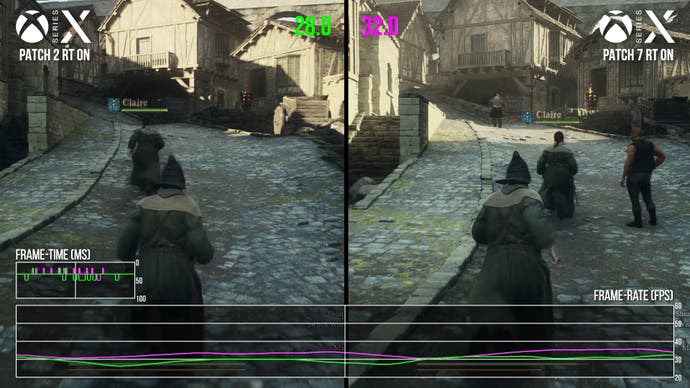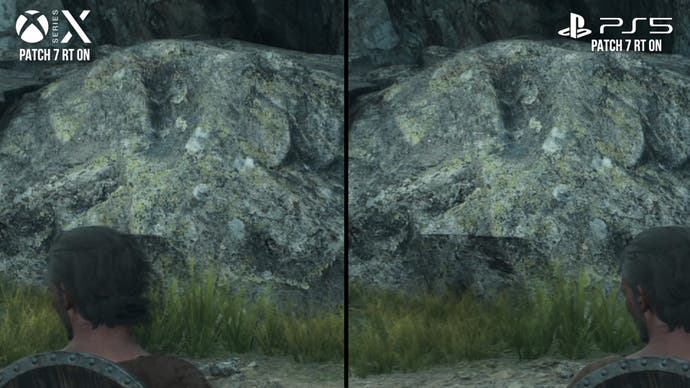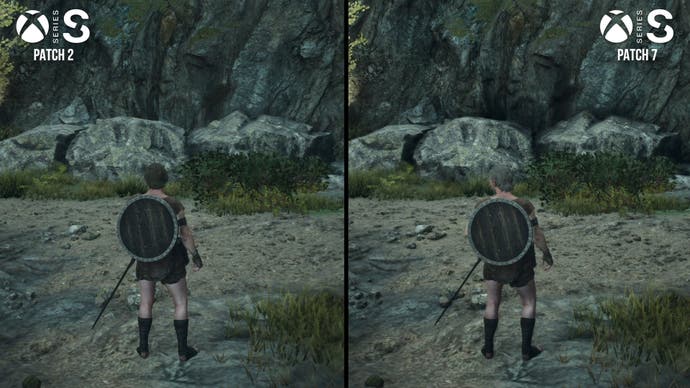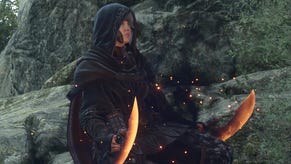Is Dragon's Dogma 2 finally fixed with patch 7 for PS5 and Series X/S?
UPDATE: The game's low/high toggle also adjusts resolution.
UPDATE: We're updating this article to correct an error. The low/high settings toggle does more than disabling motion blur and RT. In side-by-side shots on Series X, the game is clearly less detailed and lowerin resolution with the low settings preset enabled, as opposed to the game running with the high settings preset with RT and motion blur disabled. Other visual settings seem to be identical. The game running with the low preset also runs faster than the game set to high with RT and motion blur disabled, at least in GPU-limited areas. The PS5 is similar to Series X with the low preset in image quality.
Similar to other GPU-limited areas of the game, the PS5 runs somewhat slower than Series X with the low preset. We've put together a short video that shows the differences and the performance uplift using the low setting in a GPU-limited scenario.
Original article: Dragon's Dogma 2 is a beautiful title that may go down as one of the best looking games of the year. Capcom's open-world epic features some outstanding lighting technology, with detailed ray-traced global illumination (RTGI) giving the title a very refined appearance. Despite this technical achievement, the game shipped with substantial performance and visual faults, with broken image reconstruction on Xbox Series machines and frame-rate issues in dense city areas, in addition to other issues.
That was true both for the game's launch version as well as its second patch, which we covered in a video shortly after launch. Just last week, Capcom debuted a new patch, simply called patch seven, which promises frame-rate uplifts and new visual toggles. Does this update cure Dragon's Dogma's ailments, or does it still suffer from key technical flaws?
Let's start with Series X. In terms of basic visual settings, we're looking at a largely similar experience between the second and seventh patches. We still see the same beautiful RTGI presentation with ray tracing turned on, with a noticeably less striking appearance when RT is set to off. I couldn't really spot basic settings tweaks between the two patches, which is about what you'd expect.
Thankfully, the reconstruction issues that plagued Series X have been resolved - at least somewhat. Earlier versions of Dragon's Dogma 2 had really obtrusive checkerboarding artefacts on Series X, with the game presenting a pixelated and less detailed image than PS5. In the new version, these artefacts are much less noticeable, but the final resolve still appears less crisp than PS5. I believe the game is checkerboarding to 4K on both consoles here, but it's just not working right on Series X.
The game features a new visual toggle as well, with players able to select between "high" or "low" graphics quality settings. All this setting appears to do is toggle ray tracing and motion blur. I suppose this could be helpful to some users, but I think it adds unnecessary complication and implies misleading things about the performance penalty that motion blur carries. The overwhelming majority of the performance difference between high and low is going to stem from RT, because toggling motion blur on or off on its own produces a very minimal frame-rate impact. It's just not an especially demanding technique on current-gen console hardware. [UPDATE: Please note the correction above - resolution also lowers in the low mode, improving performance in GPU-limited situations.]
Performance has seen some tweaks too, though the game typically performs identically when testing the two patches across a range of game content. Expect a wobbly performance level by default, with the game performing better when RT is disabled. In common with a few other RE Engine games, the developers don't seem to really be aiming for a specific frame-rate target; the game just runs in a sort of no-man's-land between 30 and 60fps in typical play.
The second patch did introduce an option for a 30fps cap, but it was broken with poor frame-pacing... and that's still the case with patch number seven. The game definitely feels more consistent, but its occasional frame-time wobbles give it an unsteady feel on a conventionally refreshed display.
The only step forward is that the game does benefit from substantial performance uplifts when CPU-bound in NPC-dense areas, such as in Vernworth, the game's central city area. Going for a jog around the city, performance is elevated substantially in the new patch.

Initially I suspected that some tweaks to NPC density or pop-in might be responsible, but side-by-sides reveal ambiguous results. Sometimes pop-in seems worse on one patch, other times on the other, and crowd size likewise differs moment-to-moment. There isn't a fixed distance where NPC draw occurs on either patch, so the results overall are similar enough to call this one a draw. The performance improvements must therefore come from other optimisations.
One final detail is that the patch notes mention support for a 120Hz output, but Xbox Series consoles already supported 120Hz system-wide. What this does mean is that with 120Hz toggled on at both the system and the game level, the frame-rate is allowed to exceed 60fps where GPU and GPU load allows - eg by looking up at the sky with RT disabled. Low frame-rate compensation (LFC) works whether 120Hz is toggled on in game or not.
Any other visual or performance metrics seem identical across the two patches. I'd still strongly recommend playing the game on a VRR panel at 120Hz to ensure the best visual outcomes, as VRR plus LFC cleans up the game's frame-times reasonably well. That's the only way to get consistently good frame-times out of Dragon's Dogma 2 on Series X, except in Vernworth, where inconsistencies are evident even with VRR.


The PS5 code looks a lot like it did before in terms of visual settings, but ambient occlusion seems to have been fixed - previously, it looked restrained with RT disabled, and now it looks similar to the presentation on Series X. This allows the AO to provide richer indirect shading, minimising the visual differences between the RT and non-RT modes. Otherwise, the PS5 version looks similar overall to Series X, with the checkerboarding artefacts on Series X and the PS5's superior image quality being the key differentiating factors.
In performance terms, PS5 also shows the same improvements to frame-rate in CPU-limited areas such as busy towns, while GPU-bound performance remains identical to the previous patch. It's not an earth-shattering difference, but the new patch is running consistently ahead of patch number two.
Series X still offers a performance advantage over PS5 in GPU-bound scenarios, often in the region of 10 percentage points. Conversely, PS5 can be faster in CPU-limited areas such as our Vernworth run, to the tune of around five percent with RT enabled. The difference isn't gigantic, but the PS5 does run quicker in these shots. Unfortunately, Sony's console is equally prone to the 30fps frame-pacing issues, with an uneven frame delivery even at a consistent 30fps average.

The key performance tweak on PS5 is that Dragon's Dogma 2 now supports 120Hz output, allowing it to use LFC to keep VRR enabled when the game drops below the 48Hz window. This means you can get the same smooth frame delivery that has been possible on the Xbox Series machines since launch. It doesn't magically make the game run faster, but it does smooth out frame delivery to the point where Dragon's Dogma 2 feels and looks pretty consistent, whether you cap the game to 30fps or leave it uncapped. Like on Series X, the game can also run above 60fps with these options enabled.
Lastly, we need to take a crack at the Series S. The same AO tweak we saw on PS5 is now present here, so the ambient occlusion is a lot richer than in the prior patch, providing more extensive coverage in indirectly lit areas. The game's checkerboarded resolve has also been altered, in line with Series X. The texture detail appears a bit softer now, but the artefacts are gone. It's an improvement on the whole, though image quality could be further enhanced.
Other visual settings appear identical to the second patch. The Series S still struggles with lighting quality overall, with RTGI unavailable and shadows flickering and being obviously low-res. The game's direct and indirect lighting take a big hit on the S relative to the maxed-out PS5 and Series X experience.
The saving grace here is that performance is nearly identical to Series X in GPU-bound areas, and only a touch behind in CPU-limited scenarios - which makes sense given the lower CPU clocks on Series S. You can also use the 120Hz mode to unlock the frame-rate, though I wasn't able to find any areas that exceeded 60fps. Finally, frame-pacing continues to be an issue, in common with the other consoles.
I think Dragon's Dogma has had a reasonably successful patching cycle since the second patch that we looked at back in April. Back then, I identified seven key issues where the game still needed improvement:
- Reconstruction on Series S and X is broken
- 30fps frame-rate cap is poorly implemented
- AO differences on PS5 should be addressed
- Series S lighting quality should be improved
- PS5 should use low frame-rate compensation when using VRR with 120Hz enabled
- A true 60fps-targeting mode on consoles would be appreciated
- CPU-bound performance in cities should be improved

Of these issues, only the 30fps frame-rate cap implementation and the lack of a true 60fps mode on consoles remain unresolved. I think the game is in quite good form now relative to the second patch, especially relative to the launch code. The game's three key flaws - poor CPU-bound performance, broken reconstruction on the Xbox consoles, and no proper 120Hz VRR output on PS5 - have all been addressed, at least partially. Flaws on console are a lot less glaring than they were before.
In terms of the console face-off, I'd say the results at the moment are fairly equivocal. Both PS5 and Series X pull off a rich RTGI-infused presentation - and both can achieve decent frame-delivery if you combine 120Hz output with VRR. In performance terms it's just about a draw, with PS5 faster in cities and Series X quicker everywhere else. The Series X continues to suffer from some more minor reconstruction issues though that do make the game appear less sharp, so I'd probably shade in the direction of favouring the PS5 release at the moment. Series S offers a less flattering rendition of the game's lighting and is a clear step down, though at least ambient occlusion is presenting properly on the console now.
My primary remaining concerns come down to performance. The game's 30fps cap is still sort of broken, exhibiting poor frame-pacing with frequent inconsistencies, and I'd like to see a proper mode that targets 60fps by cutting back resolution. Capcom's general approach of targeting unlocked frame-rates isn't to my taste, but at least they give more advanced users enough configurability to get frame delivery under control.
Regardless, Dragon's Dogma 2 is a noticeably improved experience as of patch 7. That assessment isn't without caveats, but I'm pleased by the progress that's been made so far.












